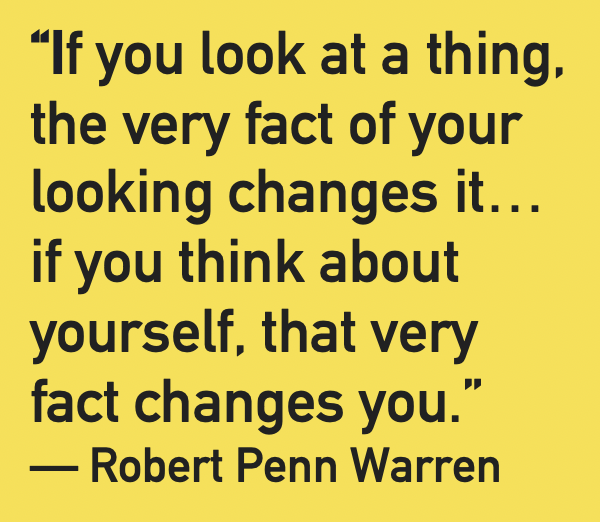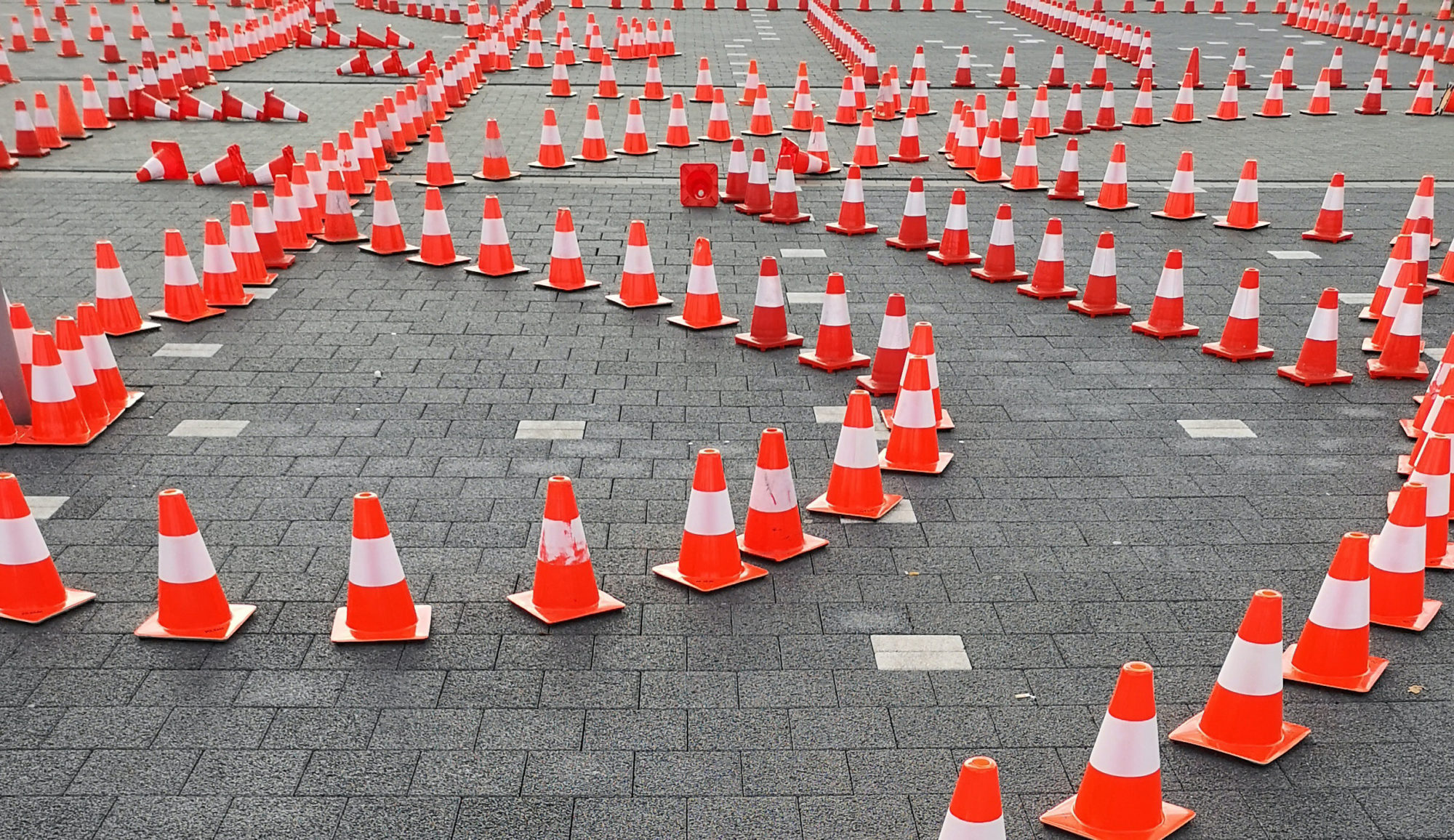
Category: Blog


Anchoring New Habits to Old Ones
Before we begin practicing a new behavior that we’d like to form into a habit, we’ll do well to consciously designate an anchor or trigger for that new habit: something that is the same every time you want to enact it. My evening walk with the dog, for example, is triggered by me leaving my office in the evening and walking into the kitchen to think about dinner, and then ultimately feeding the dog. (So, the time of day is an anchor, as is feeding the dog. After I feed the dog, I always habitually walk him.)
An anchor can be time of day, a different habitual behavior that comes right before your habit (those make good triggers)—even an emotion. For example, when you feel anxious, you may habitually pick at your nails. Or if you feel happy, you may habitually reach for your phone to take a picture. (I’m not suggesting these as good anchors or habits, mind you. Just showing how emotions are often triggers.)
A note about exercise, since so many people make resolutions about that: A general time of day is usually the best trigger, like first thing in the morning, after school, during lunchtime, or before dinner—but it can’t be the only thing that anchors your habit. Once you know generally the time of day when you’d like to do your habit, try to link your activity to an existing behavior or routine.
For example, here is the existing routine I linked my new walking habit to. It’s something that I was already doing before I added a walk into the picture. I leave the office in the late afternoon, walk across the backyard to my house, go into the kitchen, and call out to see who’s home and who’s helping with dinner. I get out the ingredients that need to be prepped for dinner, and then I feed the dog and give my family instructions for how they can help with dinner. That’s right where I inserted a walk: While the dog wolfs down his food, I now change my shoes (which are right near the dog bowls) and get a leash ready. From there, I quickly head out for a walk.
If you’ve got a habit that you don’t want to do every day, choose a trigger that occurs only when you want to do the habit. For example, “Do a thirty-minute yoga video twice a week” isn’t a habit. It’s a to-do item for your task list because there’s no clear trigger and therefore no clear automaticity. But if you work only three days a week, you can use work as your trigger: “Do a thirty-minute yoga video every weekday as soon as I walk in the door from dropping the kids off at school.”
In this free planner (see the “Goals” tab), there is a column to designate your anchor. I like to use BJ Fogg’s After I… Then I will… format (I highly recommend his latest book about habit formation, Tiny Habits). So the anchor for my dog walk is: After I feed the dog, then I will take him for a walk. Easy!
Learn more about successfully forming habits with my free eBook, How to Set a Resolution that Sticks.

Making Resolutions? Track Your Progress
What we measure, we improve. (Or, “what gets measured, gets done.”)
An important aspect of successfully getting into a habit is measurement. For example, we know that when people weigh themselves every day, they lose more weight than if they weigh themselves just once a week. This is because measurement drives awareness of behavior. For example, if you record everything you eat in a food journal, you’ll be much more aware of what you eat than if you weren’t diligently noticing and recording your food intake. So much of what we do is unconscious; measurement is about making ourselves conscious of our bad habits while we train ourselves to unconsciously out good habits.

In this day and age, tracking or measuring our progress is easy. (It’s so easy that we can sometimes get caught up in the measurement of things and spend more time playing with our recording devices than we do establishing our habits!) If you find techy ways to measure your progress fun, go for it. Otherwise, a piece of paper taped to the fridge will work!
Use this free planner (see the “Goals” tab) to designate how you’ll measure your progress. Be sure to set yourself up fully before you start practicing your new behavior! And notice that sometimes tracking habits needs to become a habit in and of itself. Consider adding “track habits” to your annual goals as well!

Why an Unambitious Habit is Better Than an Inspirational Goal
“We are what we repeatedly do. Excellence, then, is not an act, but a habit.” –Aristotle (via Will Durant)
Perhaps you are setting some resolutions and or writing out your annual goals. Fortunately, there are a few science-based tactics that massively increase the odds that you’ll be able to achieve those goals this year.
The first is to reframe your goal from the desired outcome or achievement into a daily or weekly habit. For example, resolving to eat an apple every afternoon instead of a cookie can lead to more lasting weight loss over the long run than a goal to lose 10 pounds. Similarly, spending 10 minutes each weeknight before bed cleaning out a shelf or a drawer is a better approach than resolving to declutter your entire household. Sending one networking email every morning before you leave for work will be more effective than resolving to “network more.” Our outcomes are often lagging measures of our habits: What we do repeatedly adds up. Our habits lead to our achievements.
Look at your list of what you’d like to accomplish in 2021. Perhaps you set a resolution to run a half marathon. An achievement like that will require a running habit – daily exercise. Or maybe you’d like to write a book? You’ll need to get into the habit of writing. When I’m working on a book, I set up a daily habit of writing 250 words first thing in the morning. For reference, what you’ve already read in this post before this sentence is 250 words – not much! But do that five days a week, and you’ll have enough written for a book in ten months! You, too, can write a book before the pandemic is over if you get into a daily writing habit.
The idea is to get in a habit of doing a new behavior – one that will lead you straight to your goal – every day (or nearly every day) so that it becomes automatic. Once something is a habit, no willpower is required!
So: What types of activities or behaviors will lead to the achievement you seek? Make a list. You can use the “Annual Goals + Habits” worksheet in this free planner to brainstorm. If you have a choice between activities, choose the one that you like the best, or that you want to do the most. What activity or behavior will you look forward to? What feels fun? What seems easy? What could actually count as play, or even a leisure activity?
If your smaller behaviors seem too fun or too easy to ever accomplish something big like writing a book or running a long road race, you are on the right track! Habitual behaviors that automatically help you achieve your goals make better self-improvement initiatives than shooting for an ambitious outcome.
For more information about getting into good habits, download my free step-by-step guide “How to Set a Resolution that Sticks.”

If You Don’t Think About This, You Probably Won’t Achieve Your Goals
A fascinating line of research shows that the more we fantasize about achieving a challenging goal, the less likely we are to actually take a real-life step towards accomplishing that very goal.
So much for positive thinking and visualization practices! It turns out that daydreaming about our success is relaxing, but it isn’t energizing. We envision ourselves hopping off the couch and going for a run, and our brain reacts as if we’ve already gone for that run. Psychologists call this “mental attainment,” and it can really thwart us as we attempt to keep our resolutions and get into good habits.
Fortunately, related research shows us exactly what to do to avoid this surprising brain booby-trap. We need to follow up our resolution or goal setting with something researchers call “mental contrasting.” Here’s how:
Step One: Identify the Obstacle Within Yourself
Take a moment to stop to imagine what will prevent you from reaching your goals or keeping your resolutions. Start by imagining the external circumstances that might thwart you. Maybe you need support from a leader at work, for example. Or maybe you need your spouse to stop leaving junk food on the kitchen counter. Are those external obstacles overcomable? What will you need to do to make sure they aren’t roadblocks to your success? If needed, re-write your goal or resolution so that you feel you have a good chance at succeeding.
Once you’ve narrowed your resolutions down to goals that are challenging but that you still feel pretty confident you can achieve, identify how you will likely hold yourself back. What is it within you that will predictably stand in the way? How will you predictably self-sabotage? For example, maybe you’re afraid to ask that leader at work for support. Or perhaps you often shop while you are hungry…and so you are bringing junk food into the house.
Anxiety, stress, and laziness are common emotional obstacles. Bad habits and limiting beliefs (or incorrect assumptions) are others. What obstacles can you imagine you’ll face? You can use the “Make Plans for Obstacles” worksheet at the end of this free eBook to get started.
Step Two: Make a Plan
What will you do in the face of these obstacles? What instrumental behaviors will help you overcome the obstacles you’ve identified? Frame your plan using an IF/THEN sentence. For example:
- IF it rains, THEN I will still walk the dogs, and I will use the umbrella that is in the front hall.
- IF I feel anxious about asking my manager for support, THEN I will remind myself of the times when she has said that she is happy to help.
- IF I start to feel too overwhelmed to get started, THEN I will close all open browser windows, close all my apps, turn off my phone, and focus on one thing at a time.
A great deal of research shows that when people make a specific plan for what they’d like to do or change, anticipating obstacles if possible, they do better than 74 percent of people who don’t make a specific plan for the same task. Making a specific action plan dramatically increases the odds that you’ll follow through.
People who plan for obstacles tend to be able to meet their goals more successfully. For example, research shows that recovery from hip-replacement surgery depends in large part on having patients make a specific plan for how they will deal with obstacles.
It’s very painful to get up and move around after hip surgery. At the same time, recovery is generally more successful if a patient gets up and walks around a lot. In this study, patients who had just undergone surgery thought about getting up and walking around. Then, they made plans to handle the pain. So if their goal was to walk to the mailbox and back every day, participants practiced thinking: Okay, I’m going to get about halfway there and it’s going to hurt like heck and I’ll want to turn around.
Patients wrote down what they were going to do when they got halfway there and it hurt like heck. These patients recovered faster. They started walking twice as fast and could get in and out of a chair by themselves three times faster than people who didn’t make a specific plan to deal with the pain.
In sum: It is extremely important whenever we establish a new habit to think through all the seemingly minor details. Especially the details that tend to hang us up in the end. We need to decide what the key factors are for our success and how, specifically, we can set ourselves up to overcome the obstacles we may face.
You can use this technique daily by (1) jotting down a problem you need to solve or something that you’d like to accomplish, (2) noting what is likely to hold you back, and (3) making an if/then plan. To make this easy for you, I’ve included these steps in my new planner (it’s free online!), which you are free to customize and print out.

Coping with Constant Interruption + Tips for Focus
Several years ago, I devised a system for quickly getting into the “zone” while I worked. Free from distractions and interruptions, I wrote quickly, joyfully, and with surprisingly little effort.
But now freedom from distractions and interruptions seems like a fantasy. My husband and I are both working from home and our kids are doing school from home. Although we all have designated places to work, my family is forever interrupting me, jarring me out of my flow. For example, my husband likes to use the printer that is in my office (because I keep the paper and toner filled). He’ll saunter into my office to pick up whatever he’s printed, and even if I’m clearly trying to focus, he’ll put his face right in front of my computer screen and lean in for a smooch.
I recognize how sweet this is. And I am super grateful to have such a loving and affectionate husband. And I appreciate that I still have work. And I do like seeing him and our kids so much.
And also…Like many parents these days, I’m a little on edge, and each interruption has the potential to unleash a riptide of irritation. Even when the person interrupting me is a considerate and whispering teenager needing a change of scenery (“the chair in your office is so comfortable!”), or a loving husband who wants to shower me with affection, I sometimes feel frustrated and snappish.
Am I overreacting? Perhaps I could try harder to keep my irritation in check, but research gives me some grounds for it. In fact, studies have found that getting interrupted isn’t just a nuisance; it’s costly and problematic.
Here are three sometimes hidden costs to interruptions.
For starters, they cost us a lot of time.
On average, interruptions take 23 minutes and 15 seconds to recover from–even if the distraction is only a minute!
For example, say I’m uber-focused, but then my hubby comes in for a minute or two to chit-chat about dinner plans. Before I turn my attention back to my work, I might decide to take a quick peek at my email, and while I’m doing that, notice that I’ve missed a call and three texts. If I answer just a few of these incoming communications, it may well be longer than 23 minutes before I get back to work.
I suppose, if I tried really hard, I could get back on track faster. But that effort takes focus and energy that I could be putting toward my writing or other work.
Second, interruptions lower the quality of our work.
A mountain of research has demonstrated time and again that interruptions increase our error rate. For example, when college students that are concentrating on a task are interrupted for 2.8 seconds, they make twice as many errors as those who are not interrupted. When they are interrupted for 4.4 seconds, their error rate triples.
According to Glenn Wilson at the University of London, just being in a work situation where you can be interrupted by text and email can decrease your IQ by 10 points. For writers like me, the news here is even more depressing: Interruptions measurably lower both the quantity and the quality of writing we can do in even a very short period of time (20 minutes).
Finally, interruptions contribute to stress and overwhelm, making us feel conflicted and time-pressured.
As we shift our focus between tasks–as when we steal a glance at our email while we are working on a presentation–it increases our perception that we have too much to do in the time that we have to do it.
According to Gloria Mark, who studies interruption at UC Irvine, when we are diverted from one task to another, we can pick up our work pace to make up for lost time, but this increased speed comes at a cost: People who’ve been interrupted report having a greater workload, more stress and frustration, feeling more time pressure, and exerting more effort.
And guess what? This makes a lot of people feel annoyed, anxious, and irritable, as I do. Behavioral scientist Alan Keen believes the stress and overload that comes from constantly being expected to multitask is causing an “epidemic of rage.” Interruption and task switching raises stress hormones and adrenaline, which tends to make us more aggressive and impulsive.
In other words, interruption drains our energy and dampens our performance. The stress, inefficiency, inaccuracy, and time pressure that interruptions create are the very opposite of being in the sweet spot.
None of us needs the added stress of daily, constant interruptions during these difficult times. But for most parents working from home, near-constant interruption is inevitable. We can work hard to eliminate interruptions (see below for ideas about how), but in all likelihood, our efforts will often be thwarted.
Simply understanding why we feel so irritated by constant interruption can help. Research shows that identifying and labeling a difficult experience and the emotions that go with it allows us to recover a modicum of control. This “name it to tame it” technique works by decreasing activity in the brain’s fear and emotion centers, like the amygdala, and increasing activity in the frontal lobe, where reasoning occurs.
Labeling what is happening with us in the present — both the fact that we’ve just been interrupted again and the way we are feeling about it — is a form of acceptance. Acceptance is not the same as resignation; it’s not that our efforts to eliminate interruptions will never work, or that things won’t improve. Everything changes. But accepting our present reality does tend to make us more effective in the face of challenge. And fortunately, it can help us feel better.
Tips for Finding Focus
Without focus, kids struggle to learn and parents struggle to work. To minimize the interruptions and distractions that kill focus, we can do the following:
Designate a learning or working playing field.
We all need a place where we can concentrate, and when we designate a place that is for concentration only, we train our brains to focus better.
For example, a kid might have a specific spot at a small desk in a hallway where they do their online schooling and their homework—and only those things. You will have a different place for work. Leave your desks to check social media or do anything but focused work. Step away from your desk when you take breaks. Bonus: Our presence at that desk can be a signal to others in the household that we are trying to focus, and that everyone else needs to be quiet and careful not to interrupt.
Identify your feelings.
Interruptions and distractions can be both external (losing internet access, a Snapchat alert) and internal (feeling stressed or overwhelmed). Research shows that when we stuff our feelings down (also known as “emotional suppression”), our intelligence and learning suffer. Pretending to feel fine even when we are actually feeling something else takes energy and self-control, and that steals the energy and willpower needed to focus.
The task here is to identify what we are feeling, not necessarily why we are feeling that way. This can be difficult. We can get attached to our narratives about why we are upset and get caught up in trying to problem-solve. But that won’t help us focus. We need to talk about the actual emotions, not the reasons for the emotions.
Encourage single-tasking.
It might seem blazingly obvious that in order to focus, we will need to focus on one thing at a time, but this is no longer the way of the world. Even though multitasking is wildly inefficient, it feels productive. Especially for kids who are feeling bored and stuck at home, having a lot of screens open and alerts coming in makes them feel busy and stimulated.
But multitasking is the enemy of focus. The human brain did not evolve to focus on many things at once, and it can’t actually do it—it can only switch rapidly back and forth between tasks. This is a giant energy drain for our brains in many ways. It makes us tired (or wired) and inattentive. Most of all, multitasking makes learning and working inefficient.
We do better when we configure our work and learning environments, our devices, and our online time so that we aren’t tempted to multitask—so we’re less distracted by alerts and less tempted to check social media compulsively. Turn off all alerts and turn on “do not disturb” when you are trying to get into the flow.
Looking for more ways to find focus?
Check out Unit 4 of my online class, The Science of Finding Flow:
Introduction to Unit 4 – Focus!
Step Awaaaay From the Busyness Competition
Video: An Illness We Are Choosing
Activity #1: Schedule Time to Single-Task
How Bad, Really, Are Interruptions?
Activity #2: Build Yourself a Focus Fortress

Dear Christine: What If I Don’t Agree With My Co-Parent?
Trying to get your co-parent to parent your way? Here’s what to do.
Dear Christine,
What should I do if my husband and I don’t agree about family rules? For example, I really want to establish your no-phones-in-the-car rule, but my husband won’t enforce it. He often lets our kids use their phones when he is driving (or pretends not to notice that their phones are out). And when we are all in the car as a family, it’s too hard for me to be the one insisting that the kids get off their phones when they know that he will allow it.
Please help.
Sabotaged Spouse
Dear Sabotaged Spouse,
We know it is much better for kids when parents cooperate—when we are all “on the same page” and we “present a united front.” There are mountains of research that demonstrate that conflict between parents is bad for kids, and collaboration is good for them. We all get it…right? And yet many of us struggle to get co-parents on our page. It’s so frustrating to not be able to control other people! Especially when we are right! I know just how darn frustrating it can be when a spouse or co-parent doesn’t want to get on board with one of my fantastic (and science-based!) parenting ideas. This is a hard issue.
I’m only sort of kidding. I certainly have given a lot of thought to what best parenting practices are, and the strength of my convictions is pretty mammoth. How can I back down when I feel so strongly? And my husband is also very strong-willed (and not a big reader of research or parenting books).
So, again, it’s hard. And also: We must carry on.
The first step is acceptance. We can’t change our co-parents, tempting as that might be to try and do. Trying to change a grown human is a fool’s errand. Not because people don’t change—they do—but because we can’t force change in other people. The only truly effective option is to practice what we preach ourselves, and hope it rubs off on our co-parents. (Besides my husband, I also co-parent with my first husband and his wife, my daughters’ stepmom. Fortunately, we are pretty naturally on the same page!)
What has happened for me, and what I hope happens for you, is that the other parents in my life notice that the way that I parent works, and they can see that what I’m doing is rewarding for everyone. The kids respond, so my co-parents tend to be more motivated to mimic what I’m doing.
However, I’m also prone to overhelping my co-parents, which kills their motivation. When we overhelp, we subconsciously send the message that we believe that they can’t do it without us. This can make them feel like they’re being criticized or like they need fixing, and that can hurt. People don’t appreciate it when their spouse (or former spouse or former spouse’s new spouse) don’t accept them as they are. Often, overhelping others gives us a false sense of power that can distract us from our own problems. As Anne Lamott says, “Help is the sunny side of control.”
Fortunately, we can still help each other parent more authoritatively by supporting three basic psychological needs related to self-motivation: autonomy, competence, and relatedness.
We can support autonomy by backing off a little. Let them make their own decisions about how they’ll parent, even when they parent differently from you. This means practicing acceptance, as they are probably already parenting differently, whether or not we “let them.”
We can ask questions that help them build a vision for success and help them focus on the outcomes that they want. What does good parenting look like to them? How are they hoping to feel? And what will they need to do to succeed? Where will they need to ask for help?
We can encourage their competence by helping them build the skills they need. Do they want you to teach them what you’ve learned? What you are reading about in this book? What you are practicing?
No? Then take a deep breath and back off.
Finally, we can foster relatedness by building a sense of family. How can you find security in doing something together? Can you create common goals and common values? How can you make it fun to do together?
In the end, Sabotaged Spouse, the best thing you can do is to keep your own side of the street clean. When you feel frustrated that your spouse isn’t doing it right—or you fear that he’s undermining you—take a deep breath and turn your attention back to yourself, and to the things that are within your control. It is never too late for you to be the parent you want to be.
Love,
Christine
In Dear Christine, sociologist and coach Christine Carter responds to your questions about marriage, parenting, happiness, work, family, and, well, life. Want to submit a question? Email advice@christinecarter.flywheelsites.com.

Seven Ways to Cope with Uncertainty
What should we do when everything feels so out of control?
Living with so much uncertainty is hard. Human beings crave information about the future in the same way we crave food, sex, and other primary rewards. Our brains perceive ambiguity as a threat, and they try to protect us by diminishing our ability to focus on anything other than creating certainty.

Research shows that job uncertainty, for example, tends to take a more significant toll on our health than actually losing our job. Similarly, research participants who were told that they had a 50% chance of receiving a painful electric shock felt far more anxious and agitated than participants who believed they were definitely going to receive the shock.
It is no surprise, then, that there are entire industries devoted to filling in the blanks of our futures. See, for example, the popularity of astrology apps, or the prestige of management consultancies dedicated to strategic planning. Fundamentalist religions counter anxiety by providing us with unambiguous rules and absolute truths. Conspiracy theories provide us with simple explanations for complex phenomena.
But sometimes—maybe always—it’s more effective not to attempt to create certainty. Though evolution might have rigged our brains to resist uncertainty, we can never really know what the future will bring. And in improbable situations like the pandemic, which has massively disrupted our routines and utterly destroyed our best-laid plans, we need to learn to live with ambiguity.
“Uncertainty is the only certainty there is,” wrote mathematician John Allen Paulos. “Knowing how to live with insecurity is the only security.”
So how can we best cope when everything feels so out of control? Here are seven surprising strategies.
1. Don’t resist
There’s no doubt: We are living through challenging times. But resisting this current reality won’t help us recover, learn, grow, or feel better. Ironically, resistance prolongs our pain and difficulty by amplifying the challenging emotions we are feeling. There is real truth to the aphorism that what we resist persists.
There’s an alternative. Instead of resisting, we can practice acceptance. Research by Kristin Neff and her colleagues has shown that acceptance—particularly self-acceptance—is a counterintuitive secret to happiness. Acceptance is about meeting life where it is and moving forward from there.
Because acceptance allows us to see the reality of the situation in the present moment, it frees us up to move forward, rather than remaining paralyzed (or made ineffective) by uncertainty, fear, or argument. To practice acceptance, we surrender our resistance to a problematic situation, and also to our emotions about the situation.
For example, you might find your marriage to be particularly challenging right now. Instead of criticizing or blaming your spouse—two tactics of resistance—you could calmly accept your marriage for the time being.
That doesn’t mean that you won’t feel frustrated anymore, or disappointed, or saddened by the state of things. A big part of acceptance is accepting how we feel about difficult circumstances (and difficult people) in our lives. But allowing our challenging marriage to be as it is right now—and acknowledging our feelings about it—puts us in a better position to move forward.
To be clear, acceptance is not the same as resignation. Accepting a situation doesn’t mean that it will never get better. We don’t accept that things will stay the same forever; we only accept whatever is actually happening at the moment. We can work to make our marriage happier, while at the same time allowing the reality that right now, the relationship or the situation is complicated. Maybe it will get better, maybe it won’t. Practicing acceptance in the face of difficulty is hard, and it’s also the most effective way to move forward.
2. Invest in yourself
The best resource that you have right now for making a contribution to the world is YOU. When that resource is depleted, your most valuable asset is damaged. In other words: When we underinvest in our bodies, minds, or spirits, we destroy our most essential tools for leading our best lives.
We humans don’t do well when we defer maintenance on ourselves. We need to sustain the relationships that bring us connection and meaning. We must get enough sleep and rest when we are tired. We need to spend time having fun and playing, just for the joy of it.
Don’t be confused: Self-care is not selfish. Selfishness is an anxious focus on the self. Selfish people tend to refer back to themselves a lot by using words like I, me, and mine. They pursue extrinsic goals, such as preserving their youthful beauty or cultivating an image of themselves on social media. They often hunger for more money, power, and approval from others, and they are often willing to pursue these things at the expense of other people or at the expense of their own integrity. That sort of self-focus is linked to stress, anxiety, depression, and health problems such as heart disease.
So, I’m definitely not recommending selfishness. I’m suggesting self-care and personal growth.
3. Find healthy comfort items
One of the most important ways we can invest in ourselves is to comfort ourselves in healthy ways.
If we are to stay flexible, we need to feel safe and secure. When we feel uncertain or insecure, our brain tries to rescue us by activating our dopamine systems. This dopamine rush encourages us to seek rewards, making temptations more tempting. Think of this as your brain pushing you toward a comfort item…like an extra glass of wine instead of a reasonable bedtime. Or the entire pan of brownies. Or an extra little something in your Amazon cart.
But instead of turning to social media, junk food, or booze to soothe our rattled nerves, we do better when we preemptively comfort ourselves in healthy ways.
Make a list of healthy ways to comfort yourself. Can you mask up and go for a hike with a neighbor? Schedule a call with a friend? Reflect on what you are grateful for? Let yourself take a little nap? Perhaps you could seek out a hug or watch a funny YouTube video.
Those things may seem small—or even luxurious—but they enable us to be the people that we want to be.
4. Don’t believe everything you think
Perhaps the most essential stress-reduction tactic that anyone has ever taught me is not to believe everything I think. In uncertain times, it’s particularly important not to believe thoughts that argue for the worst-case scenario.
It can be helpful for us to consider worst-case scenarios so that we can weigh risks and actively prevent disaster. But when we believe these stressful thoughts, we tend to react emotionally as though the worst case is already happening in real life, rather than just in our heads. We grieve for things that we haven’t actually lost, and react to events that are not actually happening. This makes us feel threatened, afraid, and unsafe when we are simply alone with our thoughts.
Our negativity bias can also set us up for failure. Expectations can become a self-fulfilling prophecy. When we expect the worst, we often feel too afraid or close-minded to seize opportunities or respond to challenges with creativity and grit.
Instead of buying into every stressful thought, we can actively imagine the best possible scenario. We can find silver linings to replace ruminations. This counters our natural tendency to overestimate risks and negative consequences.
5. Pay attention
The opposite of uncertainty is not certainty; it’s presence. Instead of imagining a scary and unknown future, we can bring our attention to our breath. From there, we can check in with ourselves. Every time we wash our hands, for example, we could ask ourselves: How are you doing right now?
Notice what emotions you are feeling, and where in your body you feel those emotions. Bring curiosity and acceptance to your experience (see #1).
Even when it feels like everything is out of our control, we can still control what we pay attention to. We can turn off our alerts to keep the news or social media from hijacking our awareness. We can drop our ruminations and negative fantasies by attending to what’s actually happening in our inner world, right now, here in the present.
Attending to what is happening within us at any given moment keeps a crappy external reality from determining our inner truth. It allows us to cultivate calm, open-mindedness, and non-reactivity.
6. Stop looking for someone to rescue you
When we act as though we are powerless, we get trapped in narratives that leave us feeling angry, helpless, and trapped. And we start hoping other people will save us from our misery.
Although it can feel good when others dote on us, most rescuers don’t really help. Our friends might want to save us—because helping others makes people feel good—and their intentions may be noble. But rescuers tend to be better enablers than saviors. If we stay stuck, they get to keep their role as our hero, or they get to distract themselves from their own problems.
Rescuers tend to give us permission to avoid taking responsibility for our own lives. On the other hand, emotionally supportive friends (or therapists) see us as capable of solving our own problems. They ask questions that help us focus on what we do want instead of what we don’t.
“Uncertainty is the only certainty there is”
In short: To best cope with uncertainty, we need to stop complaining. When we drop our fixation on the problem, we can focus on the outcomes we desire. How can we make the best of this mess? What can we gain in this situation?
When we take responsibility for our lives, we trade the false power of victimhood for the real power that comes from creating the life we want.
7. Find meaning in the chaos
Social psychologists define meaning, as it applies to our lives, as “an intellectual and emotional assessment of the degree to which we feel our lives have purpose, value, and impact.” We humans are best motivated by our significance to other people. We’ll work harder and longer and better—and feel happier about the work we are doing—when we know that someone else is benefiting from our efforts.
For example, teens who provide tangible, emotional, or informational support to people in crises tend to feel more strongly connected to their community. Research shows that we feel good when we stop thinking about ourselves so much and support others.
When we see something that needs improvement, our next step is to recognize what we personally can do to be a part of the solution. What skills and talents (or even just interests) can we bring to the issue? What really matters to us, and how can we be of service?
Meaning and purpose are wellsprings of hope. When the world feels scary or uncertain, knowing what meaning we have for others and feeling a sense of purpose can ground us better than anything else.
So, don’t sit back wait for certainty; it’s not coming. What have you always wanted to do? What outcome are you hoping for? How can you make a real life in this? Live that life.

My Kids Have Nothing to Do This Summer. Now What?
This Dear Christine column offers tips for structuring your family’s summer during the pandemic.
Dear Christine,
Since school ended, my whole family is floundering. We have no summer plans. I’m feeling some pressure to make up for “COVID slump,” but I haven’t a clue how to do so. Neither of my teenagers has summer jobs or internships, and neither is interested in taking an online class. We need to find a purpose this summer—all of us. What, even, is the goal?
Warmly,
A Floundering Family
Dear Floundering,
You aren’t alone! Day-to-day life without structure and routine is hard. We human beings are creatures of habit, and when our routines are disrupted, we tend to feel anxious and agitated.
So, here’s the goal: Do something productive every day. Also, get into some semblance of a routine.
Even though your kids probably feel like there is “nothing to do,” they are going to feel better if they make themselves useful or do something creative every day. People feel good about the things that they do well. This doesn’t mean that we don’t have other sources of good feelings, but, truly, there is no other source of self-esteem than doing something—anything—well.
Also, there’s so much to be done.
I’m guessing you noticed: It’s a mess out there. My kids are tired of people telling them that 2020 is going to go down in the history books. They know that this is an important historical moment on a lot of fronts. A lot of old institutions and social structures, including our kids’ educational structures, have been profoundly shaken. If your kids are like mine, they may feel angry about all that is wrong in the world, and they may blame “you Boomers.” (For the record, kids, I’m not a Boomer.)
But, seriously, this is no time for finger-pointing. Neither is it time to wallow in self-pity or to allow ourselves to be sidelined by despair or resignation. It’s time to create the world we want to live in. We all need to get involved in fixing all the things that are broken. We need to step up and engage. What do you as a family care most about? What do your kids care about most? What role do you each want to play in making the world a better place?
This summer offers a chance to get involved in a meaningful cause. It could be through protest or activism, or it could be through learning, growth, and self-reflection, which are also productive foundations for social change.
And the goals we set for the summer should rest on that foundation. What do we want to learn or accomplish? How do we want to make a difference? The key here is not to set goals for our kids, unless we want to set the stage for endless conflict and nagging in our households (not recommended).
But using non-controlling, non-directive language, we can ask our kids questions about what they want. We can encourage them to set their own goals, letting them be guided by their own motivations (rather than what we want for them). What do they want to accomplish? What helps them feel like they are productive members of society, and of the family? What can they do every day to improve a skill that they value?
I don’t think that we need to push our kids to achieve something big this summer, and I don’t think we need to be particularly high-performing ourselves during this crazy time. Let “doing something productive every day” be a low mountain to climb. No need to construct some amazing program for your kids to counter the “COVID slump.”
Again, this is about stepping up and engaging. Whatever they, and we, are interested in is fine. And as parents, we need to hold our kids to the expectation that they will contribute to our household in meaningful ways by, say, consistently helping with dinner or emptying the dishwasher without being asked. This may not feel as meaningful to them, historically speaking, as the other productive things they do. But it will make a big difference in our households, and our sanity as parents.
Key to accomplishing these goals is creating routines around them.
Should you exercise in the morning or afternoon? Check email before or after breakfast? Work on college applications during the week or on the weekends? Shower every day? Go to bed before midnight or play video games all night?
Having a summer routine can free up a lot of energy that is otherwise exhausted by the constant need to decide what to do and when to do it. And for parents, this is even more important if we are managing (or just worrying about) our kids’ schedules.
This might seem crazy, but I ask my kids (and many of my clients) to construct their ideal day in increments of 30 minutes for themselves on a spreadsheet. I also do this for myself at the start of every new season, or when there is a big change afoot (here is an example of one created by a teenager for summer).
Developing a daily routine is about deciding how you will spend your time. More specifically, it’s about deciding what you will do and when you will do it. The key is to decide on these things one time instead of trying to figure out how to structure your day/week/summer every morning. Once constructed, we can lean on that structure to guide our daily life.
I like to think about our daily activities in terms of five big buckets:
- Physical. How will we get some exercise? Is there something athletic we’d like to train for? How can we move our bodies throughout the day? What are other components of physical health that are important to me?
- Emotional. How can we care for our psychological health by bringing some enjoyment into our daily life? How can we foster positive emotions like gratitude or awe? How can we connect with nature or pets or something that brings us peace or happiness?
- Social. How can we connect with the people around us? This one is tricky during a pandemic, and it is also extraordinarily important. Teenagers need to connect with their peers. Similarly, most people need to connect with sources of emotional support outside of their immediate family unit. With creativity and determination, now that it is summer this can be done outdoors in ways that lower the risk of spreading the coronavirus.
- Cognitive. Many of us get the intellectual stimulation we need through our work; kids can get it in myriad ways over the summer. What are they interested in reading? Learning more about? Can they get a jumpstart on their AP reading or SAT prep so they have less to worry about in the fall?
- Spiritual or humanitarian. This is where our daily routine can connect back to engaging in something that brings us meaning or connects us to something larger than ourselves. Teens who provide tangible, emotional, or informational support to people in crises tend to feel more strongly connected to their community. Over and over, research shows that we feel good when we stop thinking about ourselves so much and support others.
Creating an ideal day that includes each of these aspects of well-being gives us something concrete to shoot for in a world of uncertainty. Once created, we don’t have to stick to it rigidly. Often, it’s not the plan that makes the difference, but the planning process. Having decided once, we don’t have to decide every day.
Floundering Family, your teens may or may not engage in deciding on their ideal day. They may or may not decide to be productive this summer. Either way, make sure they see you do these things. That you are clear with them what the larger goal is for the summer. As parents, often the best we can do is to teach through our own example. Fortunately, with teenagers, that is almost always the best place for us to start—and it is enough to make a difference in the long run.
Yours,
Christine
In Dear Christine, sociologist and coach Christine Carter responds to your questions about marriage, parenting, happiness, work, family, and, well, life. Want to submit a question? Email advice@christinecarter.flywheelsites.com.

Resources for Learning about Racism
What am I doing to be a better antiracist? Learning — both about myself and about the racist systems, policies, and beliefs that are driving our culture.
Want to join me? You could start by taking the Harvard Implicit Bias test about race. Don’t worry if you find out that you have more unconscious bias than you realized; there is a lot we can do to dismantle our unconscious racism once we identify it. It’s helped me to see that the terms “‘Racist’ and ‘antiracist’ are like peelable name tags that are placed and replaced based on what someone is doing or not doing, supporting or expressing in each movement,” as Ibram X. Kendi, author of How to be an Antiracist, writes. “These are not permanent tattoos.”
Reading Ideas
Real American by Julie Lythcott-Haims
A poetic and powerful memoir about growing up as an upper-middle-class, biracial black woman in America. I recommend listening to the audiobook!
How to be an Antiracist, by Ibram X. Kendi
Me and White Supremacy: Combat Racism, Change the World, and Become a Good Ancestor by Layla F. Saad
A 28-day “challenge” to own up to and share our racist behaviors, big and small. Powerful to do with a close friend, spouse, or discussion group.
You could also check out Kendi’s Antiracist Reading List, or one of these best-sellers about race (I hope to read them all).
Movie Ideas
13th
A documentary about the origins of America’s carceral state.
I Am Not Your Negro
The Force
The second in a trilogy by indie filmmaker Peter Nicks. (I also highly recommend the first in the series,The Waiting Room.)
I’d like to watch everything on this TIME list of expert recommendations of movies about racism and protest history.
Listening Ideas
Ten Percent Happier with Dan Harris, episode 253: An Uncomfortable (But Meaningful) Conversation about Race with Lama Rod Owens
Unlocking Us with Brene Brown: Brene with Ibram X. Kendi on How to Be an Antiracist
The Science of Happiness with Dacher Keltner, episode 29: From Othering to Belonging
“The only way to undo racism is to consistently identify and describe it — and then dismantle it.” — Ibram X. Kendi
